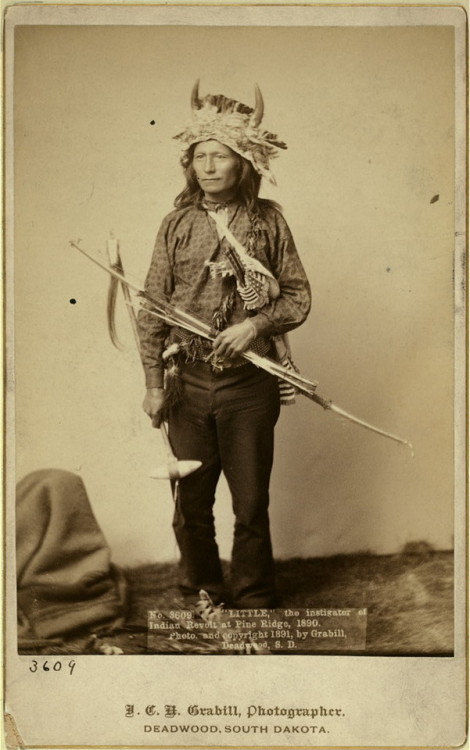onceuponatown:“Little,” the instigator of the Indian Revolt at Pine Ridge, 1890.The Pine Ridge India
onceuponatown:“Little,” the instigator of the Indian Revolt at Pine Ridge, 1890.The Pine Ridge Indian Reservation is a Native American reservation that encompasses Oglala Lakota County, the southern half of Jackson County, and the northwest portion of Bennett County in southwestern South Dakota. It is the eighth-largest reservation in the United States.The reservation has been the location of some of the most significant events in Lakota history. Home to the Oglala Lakota people, it consists of 3,468.86 square miles. The city of Pine Ridge is located in the far south portion of the reservation.Descended from the Lakota branch of the Great Sioux Nation, the Oglala Sioux inhabited much of present-day western South Dakota, including the Black Hills and the Badlands for generations. They are one of the bands of the Great Sioux Nation who gathered annually for the Sun Dance and to discuss issues of mutual concern.According to legal historian John Henry Glover, the Oglala people increasingly interacted with European fur traders in the early part of the nineteenth century. The Oglala Sioux signed their first treaty with the U.S. government in 1825, which provided for friendship and trade. Increased incursion by white settlers, however, led to conflict and war by the 1860s.This conflict was settled with the Fort Laramie Treaty of 1868, which reserved the western half of South Dakota, including the Black Hills, for the following tribes:LakotaDakotaArapaho Sicangu (Rosebud and Lower Brule Sioux Tribes)Oglala (Oglala Sioux Tribe)Hunkpapa (Standing Rock Sioux Tribe)Sihasapa, O'ohe Nunpa, Miniconjou, Itazipcho (Four bands comprising the present-day Cheyenne River Sioux Tribe)Iháŋkthuŋwaŋ (Yankton Sioux Tribe) Iháŋkthuŋwaŋna (Yanktonai, present-day Standing Rock Sioux Tribe)Isáŋyathi (Santee Sioux Tribe) In 1874, however, George Armstrong Custer, an officer in the United States Army, lead an expedition into the Black Hills. Miners who accompanied him discovered gold and things would never be the same for the Great Sioux Reservation.The gold discovery led to a flood of prospectors into the Black Hills, sparking tensions between American Indians and white settlers and prospectors. The U.S. government made minimal efforts to enforce the treaty and prevent the influx.On June 25-26, 1876, after two years of bloody conflict, Lakota and Cheyenne warriors killed 263 members of the U.S. Army’s 7th Cavalry, including Custer, at the Battle of the Little Big Horn (called Greasy Grass by the Lakota) in one of the last armed efforts to preserve their traditional ways. One year later, the United States government confiscated the Black Hills and reduced the Sioux territory in treaties that were forced upon the native people.In 1889, the Great Sioux Reservation was reduced to six separate reservations, which included Pine Ridge.Pine Ridge holds an important place in Lakota history. The last Ghost Dance by the Lakota people was held at Stronghold Table, now located inside the Badlands National Park on Pine Ridge.On Dec. 29, 1890, U.S. Calvary soldiers killed approximately 150 unarmed members of the Miniconjou band of Lakota at Wounded Knee, located on the Pine Ridge reservation. More than half of the dead were women and children. -- source link
Tumblr Blog : onceuponatown.tumblr.com





